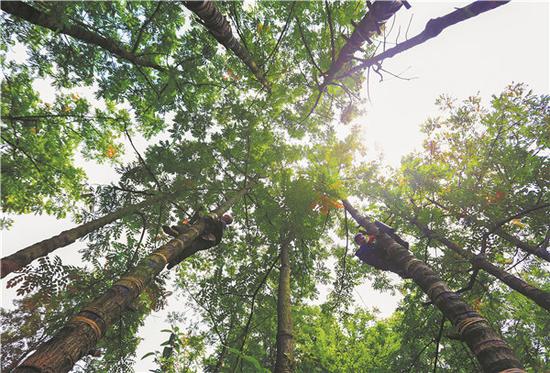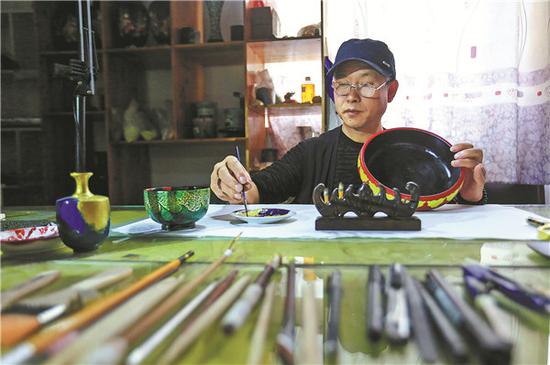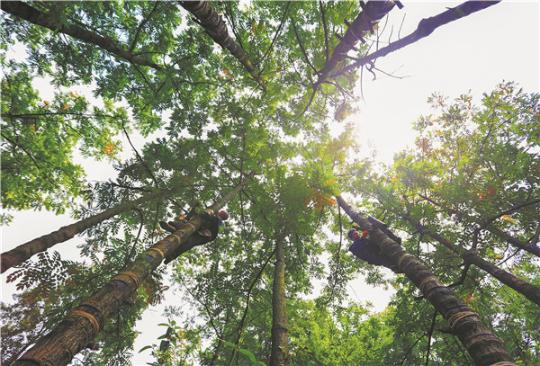Finishing product hopes for new start

Yu Zhongding (left), 73, and his cousin Yu Zhongping, 64, climb the lacquer trees to extract viscous sap in the forest of Wumeng Mountain in Bijie city, Southwest China's Guizhou province. (Photo by Wang Chunliang/For China Daily)
Traditional skill of lacquer tappers faces challenging times as interest saps away, report Wang Qian and Yang Jun in Guiyang.
Deep in the forests of Wumeng Mountain in Southwest China's Guizhou province, lacquer tapper Yu Zhongping climbs a tree using a hard leaf to collect the extracted viscous sap through a notch cut into the bark.
From May to September every year, Yu, 64, is busy harvesting lacquer, applied as a coating to protect and decorate a variety of everyday items, like bowls and furniture. When the lacquer hardens, it polymerizes and forms a protective surface that repels water and resists corrosion. As an art form originating from China, the amazing material is one of the earliest "plastics" used by humans.
"I still utilize the traditional way of collecting lacquer and will keep practicing it, which has become a part of my life," Yu from Cengtai town in the city of Bijie, Guizhou, says.
He adds that tapping is more than a business; it is a craft that needs to be inherited.
Several kilometers away, Yu Zhongping and his elder cousin Yu Zhongding, 73, leave home around 6 am and return at night during harvesting season. With their grandfathers being experts in the craft, they have been lacquer tappers since they were teenagers.
Before tapping, the first step is to attach climbing slings to the trunks, which takes about a month.
Tappers then gouge small diagonal grooves into the trees to build up its immunity and ensure a more milky and yellowish sap, according to Yu Zhongding. After 10 days, the initial tapping is conducted.
A tree can have 10 horizontal incisions in the bark for a harvesting season with the best quality of lacquer collected at notches from the third to the eighth, the senior tapper concludes.

Using the traditional way of collecting lacquer, Yu Zhongding cuts a horizontal incision in the tree bark in the forests in Bijie. [Photo by Wang Chunliang/For China Daily]
Yu Zhongping explains that when tapping lacquer, the incision should not be either too long or too deep, because if the cambium is cut, the bark will peel off and the tree cannot retain moisture, leading to its withering or even death.
"Carefully chosen, these trees can be used every three or four years for sustainable development," Yu Zhongding says, adding that usually a tree can produce hundreds of milliliters of lacquer every year.
In Dafang county, Bijie, there are more than 500,000 lacquer trees planted with the revenue from raw lacquer reaching about 30 million yuan ($4.21 million), according to official data.
The preciousness of each drop means expertise in harvesting it is crucial. Meanwhile, lacquer is toxic, and can cause severe skin rash.
On Yu Zhongding's face, there are several dark scars left by the substance.
Although facing declining demand for lacquerware, Yu Zhongping says he doesn't want to retire and hopes to pass on the tradition to future generations.
With the sap being sold at a price of about 700 yuan per kilogram, a tapper can earn about 40,000 yuan a year.
Yu Zhongding knows that the once popular career is no longer promising with tapper numbers dropping dramatically along with social development and modernization.
Gao Yan, 35, a man of the Yi ethnic group, head of a lacquerware company in Dafang county, has felt the chill. He was the son of Gao Guangyou, an inheritor of Dafang lacquer art, a national-level intangible cultural heritage of the Yi people with a history of more than 600 years.
He knows that the lacquered high-end decorative items and collectibles in the past were no longer attractive to the younger generation, who prefer products with modern designs and practical function.
Dafang lacquerware, originated in the county, is traditionally molded on a base of horse or buffalo hide that is shaped after being soaked in water and then dried over a fire.
To produce each piece of lacquerware is time-consuming and requires great skill as there are many different processes and difficult techniques involved.
The tradition originated during the Eastern Han Dynasty (25-220) and Dafang lacquerware eventually evolved into tributes sent to the imperial court during the Ming (1368-1644) and Qing (1644-1911) dynasties.

Gao Guangyou, an inheritor of Dafang lacquer art, gives the finishing touches to a bowl at his lacquerware company in Dafang county, Bijie. [Photo by Peng Youlin/For China Daily]
The varied and extensive Chinese lacquerware history can be evidenced by some of the earliest examples found at the Jingtoushan site in East China's Zhejiang province.
Dating back more than 5,000 years, the two lacquered items excavated at the site were quite simple in design. It was not until the Warring States Period (475-221 BC) that lacquerware with elaborate decoration requiring labor-intensive manufacturing processes made its first appearance.
"In terms of cultural heritage and uniqueness, traditional raw lacquer craft undoubtedly holds an irreplaceable position. The cultural significance and aesthetic value it carries are beyond the reach of modern chemical materials," Gao Yan says.
He adds that even after industrial means used for mass production, craftsmanship and handmade items still matter, which ties us to the past and inspires our creativity.
"It takes more than 50 steps by hand, spread across five main processes, including lacquer-making, embryo-making and decoration," he says.
While making intricately decorated lacquer artifacts, Gao Yan has applied the ancient art form to daily objects, such as business card cases, teapots, ashtrays and tissue boxes, to let more people appreciate its aesthetic value.
At his workshop, Gao Yan provides hands-on experience to let tourists feel the charm of the folk art.
In 2013, the local culture bureau helped set up a training center of the Dafang lacquer art, inviting the 60-year-old master craftsman Gao Guangyou to teach the ancient lacquerware tradition to hundreds of locals. To further promote the craft, the lacquerware producer in Dafang county has cooperated with Guizhou Normal University to provide courses in the craft on campus.
Even with these efforts to encourage young people to participate in the sector, Gao Yan still worries about the lack of successors, because it takes several years to become a qualified lacquer craftsman, leading to many apprentices quitting halfway.
"The artistic sense of traditional lacquerware is a comprehensive embodiment that integrates materials, craftsmanship, design, culture and the element of time," Gao Yan says. "It is not just a practical item but also an art piece capable of transmitting beauty across time and space."

